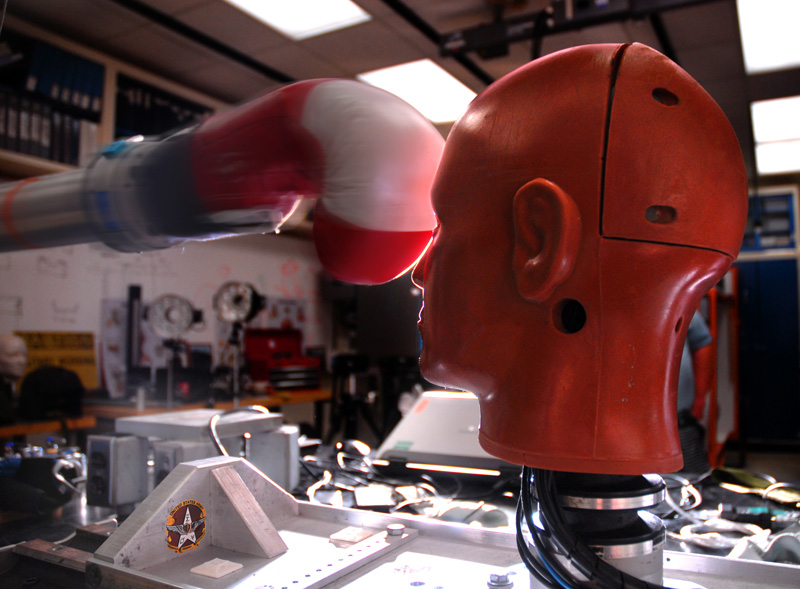Army focuses on prevention of facial injury
Facial protection is important to all of us.
The gift of sight, sound and speech are promised to no one, and each year hospitals are bombarded with injuries to treat, ranging anywhere from broken jaws and knocked out teeth to eye and ear trauma. April is National Facial Protection Month, a month dedicated to raising public awareness about the prevalence of facial injuries each year. Facial injuries pose a significant problem not only to civilians and children throughout their everyday lives, but to our Soldiers in the battlefield as well.
Continued conflicts overseas are taking a toll on our Service members, and eye and face injuries have jumped considerably on the priority list. Over the past decades, military efforts to develop body armor designed to protect the torso and limbs have taken center stage, but the focus must now be placed on the modernization and re-design of face shields and goggles to protect the face, eyes and ears.
The Military Operational Medicine Research Program, managed by the U.S. Army Medical Research and Materiel Command, is dedicated to bringing science to the Soldier and delivering the products and solutions needed to address these health and fitness needs throughout the deployment cycle. The area of facial injury falls within the Ocular and Facial Injury task area within MOMRP's Injury Prevention and Reduction Program Area.
"We lump these two together because they are both critical to maintain and enhance the Soldier's capability to shoot, move, and communicate on the battlefield," said Dr. Richard Shoge, MOMRP deputy portfolio manager. "Many protective measures worn by Soldiers are meant to protect both systems."
The MOMRP supports work being spearheaded at the U.S. Army Aeromedical Research Laboratory and their facial protection research program efforts toward development of the Facial and Ocular Countermeasure Safety, or FOCUS, headform. Using this device, researchers can measure forces applied to the facial bones surrounding the eyes and mouth.
"Currently, USAARL's facial protection research program is concentrating on filling a capability gap: the lack of a biomedical-based methodology to assess the level of blunt impact protection provided by maxillofacial protective devices," explained Mr. Frederick Brozoski, a USAARL engineer who leads the FOCUS headform team. "To provide Army materiel developers with this methodology, USAARL has a two-year project funded through Task Area A2 [Protect the Warrior from Ocular and Facial Injury] of the MOMRP."
The FOCUS headform is fully equipped with realistic human skin characteristics and bone structure, specifically designed like that of current test manikins to have the same center of gravity and mass. This design allows researchers to measure and gather valuable information pertaining to the transmission of traumatic forces applied to the facial bones surrounding the eyes and mouth.
"The first year [of the two-year project] is dedicated to identifying the types and proportions of facial injuries being sustained by our Warfighters, and to identify impact characteristics (impact velocity, impact energy, force, etc.) leading to these injuries," explained Brozoski. "In the second year, research will focus on developing a test device that accurately reproduces the facial impact characteristics, and incorporating the device into a proposed assessment methodology."
The bottom line -- in order to successfully re-design and modernize facial protection, it is essential to first understand the injuries themselves and their effect on the body.
"With the FOCUS headform and currently MOMRP funded biomedical dose-response models of the facial bones and the eye, developers of eye and face protection devices can assess the protection provided by new and emerging protection concepts," emphasized Shoge.
"USAARL has a long-standing history of research into preventing Warfighter face and eye injuries," said Lt. Col. Jose Capo-Aponte, O.D., Ph.D., research optometrist and Task Area A2 manager.
"Since USAARL's founding, our scientists and engineers have worked with developers of Army helmets, visors, and protective eyewear," said Capo-Aponte. "Our mission is to maximize the protection provided by these devices without decrementing the Warfighter's visual capabilities and military performance."
A recent Joint Trauma Analysis and Prevention of Injury Combat program report documents a total of 584 facial injuries, with 169 presenting fractures among both mounted and dismounted Warfighters. Nearly 25% of face and eye injuries sustained during combat are the result of direct hits by objects to the face, falls, and trauma resulting from motor-vehicle and helicopter crashes. Facial injuries continue to be a significant problem, with maxillary fractures and injuries accounting for the majority of wounds.
"The establishment of a task area devoted to preventing ocular and facial injury illustrates the importance of this area of biomedical research," said Capo-Aponte.















